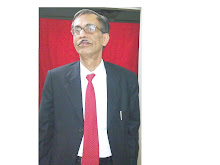One of my favourite Tagore songs during the high secondary and college education days was: "Amar Mukti Alo-ye Alo-ye A-e Akhashe, Amar Mukti Dhula-ye Dhula-ye Ghas-e Ghas-e. Deho-moner Sudur Pare Hariye Pheli Apanare, Ganer Surey Amar Mukti Urdhe Bhase. Amar Mukti Sarbo Janer Moner Majhe, Dukhho Bipod Tuchha Kara Kathin Kaaje. Biswa Dhatar Jagna Shala Atmahomer Bahni Jawala, Jibon Jeno Dae Ahyuti Mukti Aashe." Translated into English: In the light filled sky above I find my liberation, I sense my liberation in the grass and dust filled on the surface below. I free myself floating high with the rythmic waves of my songs high beyond the reach of my body and mind where I get lost and bounded. I seeh liberation in the monds of the people at large and in difficult activities defying all disappointment and dangers. In the Creator's Dynamics of creative process, I sacrifice my ego in search of liberation.
I did not care to know from some one the meaning of the song and realise that I had perhaps been doing the opposite of what I was singing. But the lyrics, tune and the music created a great appeal of my heart. I was not looking for Salvation (Mukti), Nor were I aware of my body and mind constraining in any way my urge for freedom to express and explore. But the song (Ganer Surey) would tend to beckon freedom (Mukti) that the light ( Alo) spread all over the sky (Akash). Singing this song would indeed give a feeling of spreading the boundaries of freedom (Mukti) across the sky as well as the surface of the land filled with lush green grass (Ghas) and particles of dust. I was indeed looking forward to mixing with a larger section of the population of my age, but would not have thought of sacrificing my ego for salvation. I did not know that I was getting increasingly lost to the clutchesof my body and mind.
Going to college was to expand the limits of my horizon in some sense: it would limit however the application of my mind to a fewers subjects of study. The immediate priority was to get dressed up for the movement withing an expanding domain of operation. I needed to get over from shorts to full-length tousers on a regular basis. Shirts remained the same. But as a variation and acquiring an intellerctual flavour, I had to copy the Bengali intellectuals those days in general and the leftist intellectuals in particular used as their inform: Dhoti and Punjabi. Managing dhoti was clearly difficult: but I did not use the style my father adopted and adopted the style my elder brother, Mejda followed - it wasa a more robust to faster legwork actions. But dhoti-punjabi was not a regular attire. For the shrit and truser attire, a leather belt was felt to imaprt a degree os smartness but I disliked the use of belts. Innerware remained the same but at home along with the Pyajamas I started as my own style use of discarded sarees of sister-in law and mom worn in the style of lungis (rather a kind of two-layered lungis). One kad to become more careful about cleanliness and ironing of clothes.
Part of the clothes would go be collected by the washerman vendor for 3- 7 days service. Part of the clothes were as usual washed at home - by the maild or the sister-in law or Mom, who would wash them before noon usinng dtergent cakes ( poweders/ flakes were yet to become so popular and were expensive, sometimes a bit of starch (drained water from rice cooked in the portable oven fired by soft-coke, strips of wood and cow-dung cakes), robin blue ( available in packets that showed the picture of Robin bird and used generally for white clothes) and occasionally bleaching powder - especially when the clothes were boiled to gether in water before scrubbing and washing. Men folk had little use of fluffy bathroom towels: we continued to use Gamchaas to dry our body after bath, wash the Gamchhas ourselves daily. The washed clthes were hung up on platic coiled ropes fixed in to hooks on the terrance or the backyard garden for drying throughout the afternonn and then folded and placed on the Alnaas (colthe-shelve stand made out of wood but without covers). Ironing was done using iron heated up on the oven - soon however electric irons replaced the old irons. The Rarely we would give clothes for dry cleaning to laundry shops.
Groomig also needed shaving beards, to start with once in three days and the frequency increased with time. Elder borthers and Dad was skillful in useing the traditional rajors used by barbers - they used their own specific rajors. But I prefered to use the safety blades and saftey rajors made of stainless steel. The plastic rajors and cartdges or disposable rajors were yet to come into Indian market.
You needed something else as well. A good pen and a wrist watch. I had got a Parker pen from Mejda (but it was picked up from my pocket in a crowded bus soon. So, I had to be content with cheaper varities of pen. These were still ink pen, using ink manufactured by Sulekha works in Kolkata (their factory closed down later when the dot or ball-point jotter refil pens arrived and flodded the market). How nice it was sporting a brand new wrist watch presented by my elder brother Dada on my success at the higher secondary examination.and going to college with hankerchief and comb in the pocket with an ocassional puff at ITC's Wills Navy Cut plain (costing less than a Rupee for a packet of ten ( filters were yet to come).
Monday, December 7, 2009
Subscribe to:
Posts (Atom)
